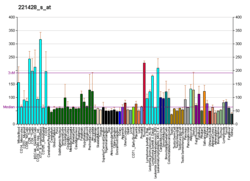TBL1XR1
F-box-like/WD repeat-containing protein TBL1XR1 is a protein that in humans is encoded by the TBL1XR1 gene.[5][6][7]
The protein encoded by this gene has sequence similarity with members of the WD40 repeat-containing protein family. The WD40 group is a large family of proteins, which appear to have a regulatory function. It is believed that the WD40 repeats mediate protein-protein interactions and members of the family are involved in signal transduction, RNA processing, gene regulation, vesicular trafficking, cytoskeletal assembly and may play a role in the control of cytotypic differentiation.[7] Mutations in TBL1XR1 have been identified in lymphomas, including MYD88 wild-type Waldenstrom's Macroglobulinemia[8]
Interactions
TBL1XR1 has been shown to interact with Nuclear receptor co-repressor 1.[6][9][10]
References
- 1 2 3 GRCh38: Ensembl release 89: ENSG00000177565 - Ensembl, May 2017
- 1 2 3 GRCm38: Ensembl release 89: ENSMUSG00000027630 - Ensembl, May 2017
- ↑ "Human PubMed Reference:".
- ↑ "Mouse PubMed Reference:".
- ↑ Zhang X, Dormady SP, Basch RS (Jan 2001). "Identification of four human cDNAs that are differentially expressed by early hematopoietic progenitors". Exp Hematol. 28 (11): 1286–96. doi:10.1016/S0301-472X(00)00539-7. PMID 11063877.
- 1 2 Zhang J, Kalkum M, Chait BT, Roeder RG (Apr 2002). "The N-CoR-HDAC3 nuclear receptor corepressor complex inhibits the JNK pathway through the integral subunit GPS2". Mol Cell. 9 (3): 611–23. doi:10.1016/S1097-2765(02)00468-9. PMID 11931768.
- 1 2 "Entrez Gene: TBL1XR1 transducin (beta)-like 1X-linked receptor 1".
- ↑ Hunter et al, Proc. American Society for Hematology 2017; Abstract 4011
- ↑ Yoon, Ho-Geun; Chan Doug W; Reynolds Albert B; Qin Jun; Wong Jiemin (Sep 2003). "N-CoR mediates DNA methylation-dependent repression through a methyl CpG binding protein Kaiso". Mol. Cell. United States. 12 (3): 723–34. doi:10.1016/j.molcel.2003.08.008. ISSN 1097-2765. PMID 14527417.
- ↑ Yoon, Ho-Geun; Chan Doug W; Huang Zhi-Qing; Li Jiwen; Fondell Joseph D; Qin Jun; Wong Jiemin (Mar 2003). "Purification and functional characterization of the human N-CoR complex: the roles of HDAC3, TBL1 and TBLR1". EMBO J. England. 22 (6): 1336–46. doi:10.1093/emboj/cdg120. ISSN 0261-4189. PMC 151047. PMID 12628926.
Further reading
- Strausberg RL, Feingold EA, Grouse LH, et al. (2003). "Generation and initial analysis of more than 15,000 full-length human and mouse cDNA sequences". Proc. Natl. Acad. Sci. U.S.A. 99 (26): 16899–903. Bibcode:2002PNAS...9916899M. doi:10.1073/pnas.242603899. PMC 139241. PMID 12477932.
- Yoon HG, Chan DW, Huang ZQ, et al. (2003). "Purification and functional characterization of the human N-CoR complex: the roles of HDAC3, TBL1 and TBLR1". EMBO J. 22 (6): 1336–46. doi:10.1093/emboj/cdg120. PMC 151047. PMID 12628926.
- Yoon HG, Chan DW, Reynolds AB, et al. (2003). "N-CoR mediates DNA methylation-dependent repression through a methyl CpG binding protein Kaiso". Mol. Cell. 12 (3): 723–34. doi:10.1016/j.molcel.2003.08.008. PMID 14527417.
- Ota T, Suzuki Y, Nishikawa T, et al. (2004). "Complete sequencing and characterization of 21,243 full-length human cDNAs". Nat. Genet. 36 (1): 40–5. doi:10.1038/ng1285. PMID 14702039.
- Perissi V, Aggarwal A, Glass CK, et al. (2004). "A corepressor/coactivator exchange complex required for transcriptional activation by nuclear receptors and other regulated transcription factors". Cell. 116 (4): 511–26. doi:10.1016/S0092-8674(04)00133-3. PMID 14980219.
- Gerhard DS, Wagner L, Feingold EA, et al. (2004). "The status, quality, and expansion of the NIH full-length cDNA project: the Mammalian Gene Collection (MGC)". Genome Res. 14 (10B): 2121–7. doi:10.1101/gr.2596504. PMC 528928. PMID 15489334.
- Yoon HG, Choi Y, Cole PA, Wong J (2005). "Reading and function of a histone code involved in targeting corepressor complexes for repression". Mol. Cell. Biol. 25 (1): 324–35. doi:10.1128/MCB.25.1.324-335.2005. PMC 538779. PMID 15601853.
- Zhang XM, Chang Q, Zeng L, et al. (2006). "TBLR1 regulates the expression of nuclear hormone receptor co-repressors". BMC Cell Biol. 7: 31. doi:10.1186/1471-2121-7-31. PMC 1555579. PMID 16893456.
- Liu Y, Sun W, Zhang K, et al. (2007). "Identification of genes differentially expressed in human primary lung squamous cell carcinoma". Lung Cancer. 56 (3): 307–17. doi:10.1016/j.lungcan.2007.01.016. PMID 17316888.





